The Synology RS1221+ vs QNAP TS-873AU NAS Compared
The appeal of rackmount servers to prosumer and medium-sized businesses has really grown in recent years. In the past, rack profile storage was largely confined to big business and enterprise users, thanks to hefty price tags and architecture that largely required on-site technical assistance. Fast forward to 2021 and we find that not only are rack-mount devices a great deal more intuitive but also their design and price tag are far more desirable to lower-tier buyers. Into this changing area of computer hardware, we find two solutions from the biggest brands in the world of NAS solutions, Synology and QNAP, each with a new half depth SMB rackmount solution that promises a full complement of hardware and software abilities to the end-user. The Synology RS1221+ and QNAP TS-873AU NAS server systems feature similar internal architecture, but after that provide a number of brand-specific features that Home and business users to enjoy their data in very different ways. So today I want to look at these two solutions and help you decide which one deserves your data.
Synology RS1221+ vs QNAP TS-873AU NAS – What Can They Both DO
Despite each brand taking a very different stance on what you need for your storage in 2020/2021, there is still a large amount of cross over in the software and utilities that each provides with your NAS purchase. With their own respective first-party applications for backups, multimedia, surveillance, VMs and more, you are going to get a remarkably well-featured device, whichever one you choose to invest in. Both Synology RS1221+ and TS-873AU systems provide/support:
- Both units feature the AMD Ryzen V1500B processor for a good price vs hardware balance
- Both can Stream and Transcode on the fly (so, live) 1080p HD or 4K media, with superior performance natively and mid-range performance in Plex, however, both do this by using software transcoding, as the main processor is not graphically embedded
- Both the Synology RS1221+ and TS-873AU NAS support AI-supported photo and ‘thing’ recognition supported to a very high degree from the free branded software included
- For Business users who currently enjoy the use of G Suite or Office 365, both of these NAS provide excellent means to backup your mass cloud accounts (as well as natively sync, dupe and configure rules on the fly)
- Both the TS-873AU NAS and RS1221+ NAS support snapshots, for more incremental and version protecting failsafe in efforts to protect you from Malware and Ransomware attacks, by allowing multi-versioning storage history to browse through and restore
- Both units are DLNA certified so can be accessed, browsed and played from by popular DLNA devices, such as Amazon Firestick, Alexa, Google Home, Chromecast, RS1221+ TV, Bose, Sonos, iPads, etc, as well as connectivity between these platforms with IFTTT
- Both are multi-bay, RAID enabled devices NAS devices that support JBOD, RAID 0 and RAID 1, RAID 5, RAID 6 and RAID 10 (as well as Synology Hybrid RAID too for their Plus series range), as well as supporting the very latest SATA based 16TB and 18TB NAS Hard Drives from brands like WD Red, Seagate Ironwolf, Western Digital UltraStar and Seagate EXOs media. As well as the Synology solution supporting their own first-party HAT5300 HDDs.
- Both devices run on their own proprietary operating system that can be accessed remotely or locally. These include regular updates to the firmware, security patches, applications and more. Ranging from multimedia, home and multi-tiered backup applications, to more business end tools such as Surveillance software, Virtual Machine deployment and business-class backup and synchronization tools.
- Both the TS-873AU and RS1221+ use and can be accessed equally by a multitude of mobile applications such as DS File, DS Video, Moments, DS Photo, DSCam and DS Music that are created by and constantly improved by Synology. As well as QFile, QMusic, QuMagie and QManager from QNAP for iOS and Android.
- Both NAS are completely compatible with Windows, Android and Mac systems, as well as acting as a bring between software platforms to share and distribute files for migration and file sync (with improvements in newer DSM 7.0 later in 2021 to Mac Finder file streaming and file pinning
- Both units can be used as a mail and/or business servers, providing excellent 3rd party CRM and first-party CMS systems. There is the Synology collaboration Suite of applications Chat, Drive, Mail, Calendar, Office and Active Backup Suite. Whereas on QNAP there is the QMail, Hybrid Backup Sync 3, Virtualization station and BoXafe tools
- Both systems support the NVR use with QVR Pro and Surveillance Station applications, support numerous cameras and arrive with at least 2 camera licenses with your purchase (8 Camera Licenses with the QNAP)
So, regardless of whether you buy the TS-873AU or RS1221+ NAS, you are going to have a remarkably functional NAS drive. But, let’s dig a little deeper into the differences between these two devices.
Synology RS1221+ vs QNAP TS-873AU NAS – DESIGN
It is particularly hard to judge a rackmount solution in terms of its design and physical appeal. Because rack-mount devices are relatively ugly devices compared with the more sleek desktop counterparts and the majority of design work by any brand goes into maintaining internal cooling and efficiency, in order for the system to maintain maximum performance overall.
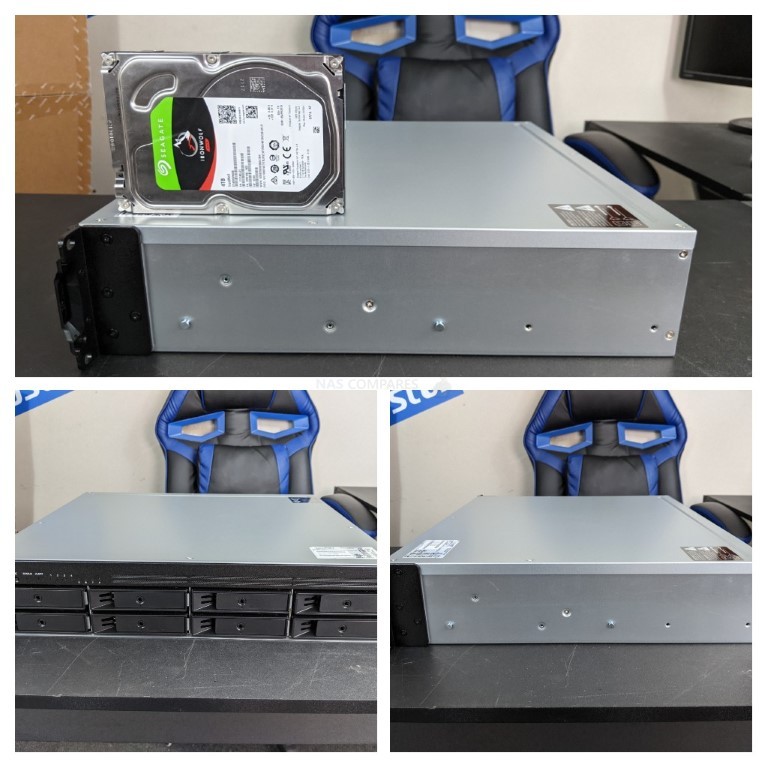
The Synology RS1221+ rackstation solution is arguably the more understated system of the two. It features a greater emphasis on front-mounted passive ventilation than that of the QNAP, and utilises the familiar chassis featured in previous generations of this product series (RS1219+ etc). In fact, the only things present on the front of this NAS aside from the main storage bays are numerous LEDs, a dedicated power button and a mute switch. Both of the RS1221+ and TS-873AU systems arrive at 30cm deep (40cm for dual PSU versions) and neither system arrives with rails included.
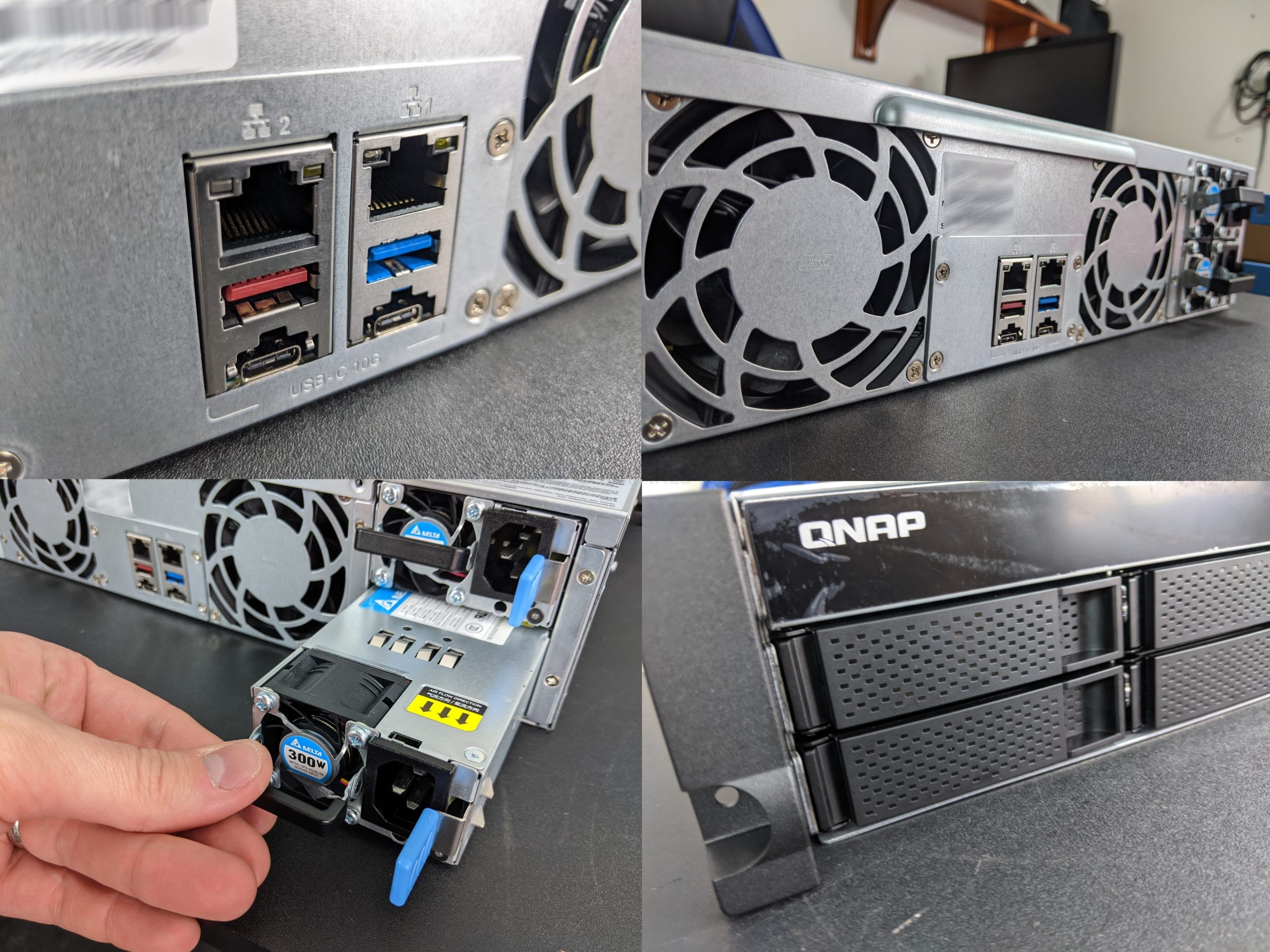
The QNAP TS-873AU and Synology RS1221+ are both 2U rackmount solutions and neither one has given way to featuring LCD information panels or any kind of visual interface on the device. It really is difficult to claim either device has an advantage in terms of design, but at a pinch, the tiniest slither of advantage goes to the Synology RS1221+ as it arrives with a fraction more passive ventilation designed into its chassis. This is still a fantastically small difference between each system though and in order to more effectively understand which one is better for you and your data, we will have to look a little deeper.
Result – You Should Buy the Synology RS1221+ NAS
Synology RS1221+ vs QNAP TS-873AU NAS – INTERNAL HARDWARE
The internal hardware featured inside the Synology RS1221+ and QNAP TS-873AU system again is rather similar and both devices are using a similar degree of component choice in their architecture. Though there are a couple of notable differences internally that show how each brand has prioritised the available PCIe lanes (x16) from that Ryzen CPU. Below is a breakdown of the internal/external hardware and we will go through those main key differences between them.
| Core Hardware | ||
| Model | SYNOLOGY RS1221+ NAS Drive
|
QNAP TS-873AU NAS Drive
|
| Processor model | AMD Ryzen V1500B | AMD Ryzen V1500B |
| Processor architecture | 64-bit | 64-bit |
| Processor clock | 4-core 2.2 GHz | 4-core 2.2 |
| Hardware encryption engine (AES-NI) | YES | YES |
| Memory | ||
| System memory | 4 GB DDR4 ECC SODIMM | 4 GB DDR4 UDIMM |
| Pre-installed memory modules | 4 GB (4 GB x 1) | 4 GB (4 GB x 1) |
| Total memory slots | 2 | 2 |
| Maximum memory capacity | 32 GB (16 GB x 2) | 64 GB (32 GB x 2) |
| Storage device | ||
| Number of Disk Slots | SATA 3.5″ & 2.5″ | SATA 3.5″ & 2.5″ |
| M.2 disk bay | No | No |
| Disk hot swap support | YES | YES |
| External port | ||
| RJ-45 Network ports | 4 x 1Gbe | 2 x 2.5Gbe |
| RJ-45 10GbE network port | N/A | 1 |
| USB 3.2 Gen 1 5Gbps port | 3 | 1 |
| USB 3.2 Gen 2 10Gbps port | 0 | 3 (2x A and 1x C) |
| eSATA port | 1 | 0 |
| PCIe | ||
| PCIe expansion | 1 x Gen3 x8 slot | 1 x Gen3 x8 slot (Adapter to convert to 2x PCIe Gen 3×4 Available) |
| Noise value* | 25.2 dB(A) | 20.1~45 db(A) |
| Timer switch | YES | YES |
| Wake on LAN | YES | YES |
| Power supply/transformer | 250W (2x 350W RP Version too) | 250W (2x 300W RP Version too) |
| Power consumption power* | 49.89 W (Access)
22.64 W (HDD Hibernation) |
55.01 W (Access)
28.98 W (HDD Hibernation) |
| Warranty | 3 years, which can be extended to 5 years coverage | 3 years, which can be extended to 5 years coverage |
As mentioned, one of the clearest elements of similarity between the TS-873AU and the RS1221+ is that quad-core processor. That embedded Ryzen V1500B has grown in popularity substantially in 2020 and has continued into 2021 with these SMB systems, bringing a great deal of performance and application support at an impressive price tag. However, the memory differences between these two systems is an important distinction. The Synology RS1221+ arrives with 4GB of DDR4 memory that is error code correction (ECC) in architecture and SODIMM in design. Alternatively, the QNAP TS-873AU arrives with 4GB of non-ECC memory in UDIMM architecture. Now, the QNAP does support the use of ECC memory (as an additional optional purchase), however, because the QNAP uses UDIMM memory, it allows the system to support up to a maximum 64GB of memory compared with the 50% less 32GB SODIMM in the RS1221+. For businesses looking at large-scale virtualisation, general VM environments, or are looking at business class surveillance, the increased maximum memory capacity is going to be more desirable than error code correction memory.
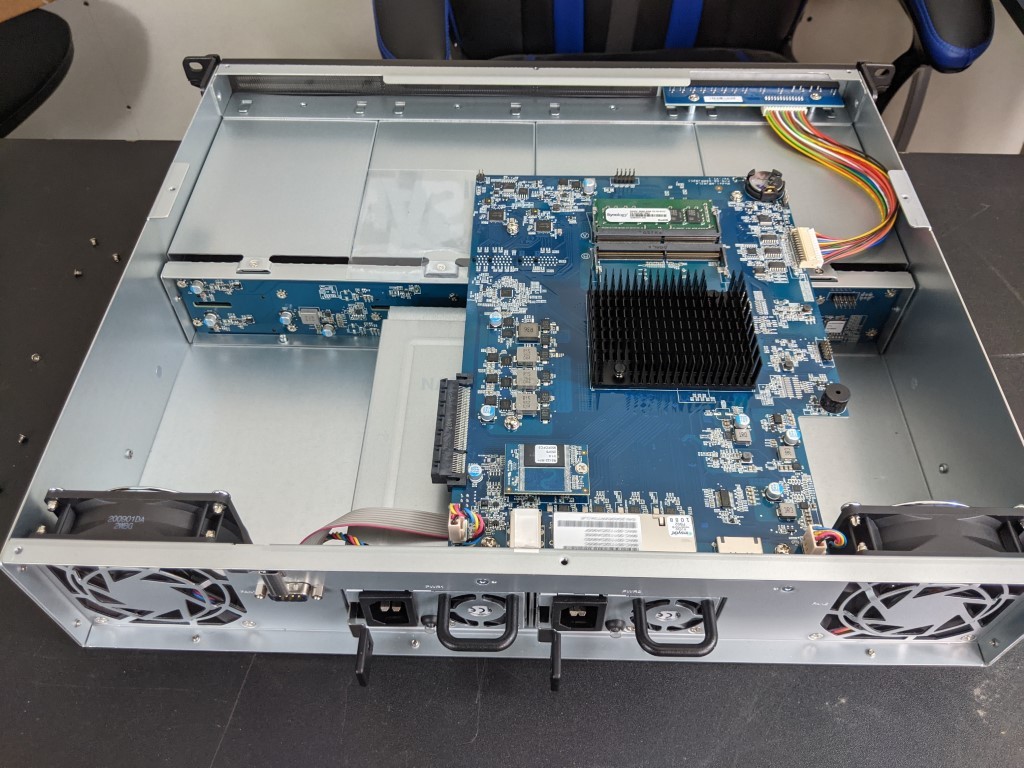 |
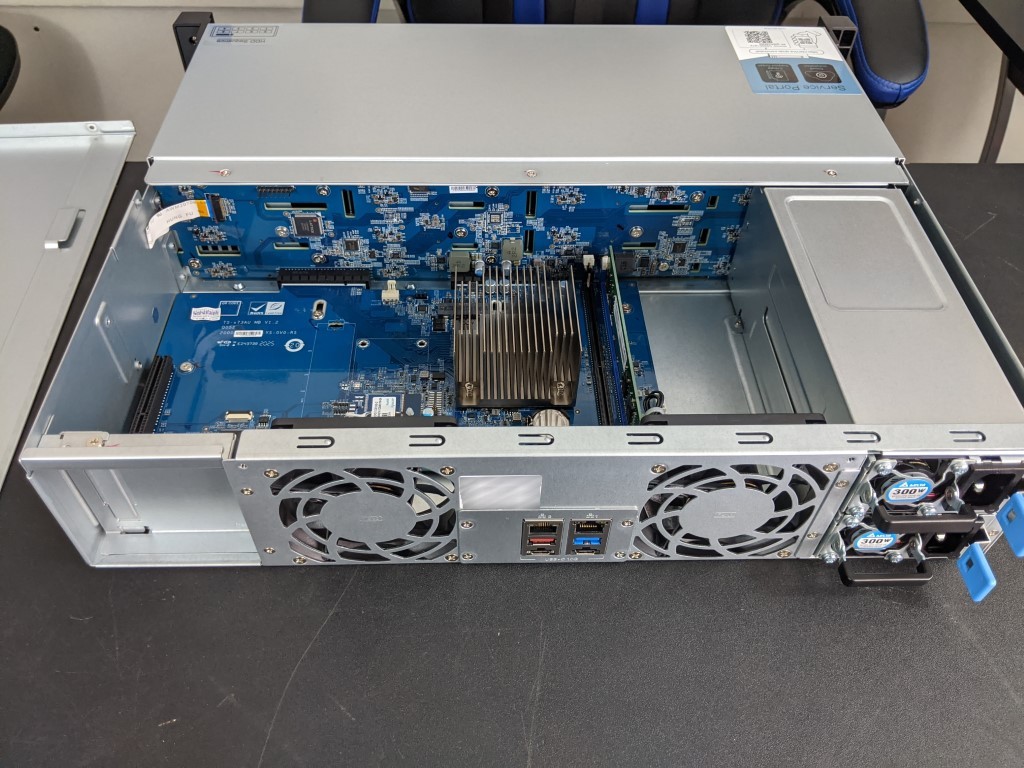 |
Another factor in the comparison between the RS1221+ and TS-873AU is that although both systems feature a PCIe gen 3 x8 upgrades slot, though the QNAP also supports an optional PCIe adapter that allows two PCIe Gen3 x4 cards instead of 1 Card at 3X8. However, it should be highlighted that the TS-873AU is still the more expensive solution of the two (at around 20-25% more expensive) and this PCIe adaptor costs you more on top. Ultimately in terms of internal hardware, the Synology RS1221+ gives you the best hardware value on day 1, but the TS-873AU gives you considerably more upgradability on the default hardware as time goes by.
Result – IT’S A TIE! Same Price, But QNAP for Max Memory and Synology for ECC Memory
Synology RS1221+ vs QNAP TS-873AU NAS – EXTERNAL HARDWARE
When I say external hardware, I really mean the ports and connections of these two devices. How you plan to interface with the Synology RS1221+ or QNAP TS-873AU NAS in your home or business environment may well impact which of these two solutions is best suited to your needs. Both systems can be accessed via the internet and via the network by multiple users at any one time, as well as arriving with numerous third-party client applications and first-party tools to utilise your data in the best way possible. But external connectivity of the Synology or QNAP NAS does differ quite a lot on both (again, on Day 1 and Day 1000) and later in the systems life, once you introduce peripherals on your client devices, the way you use the NAS might well change.
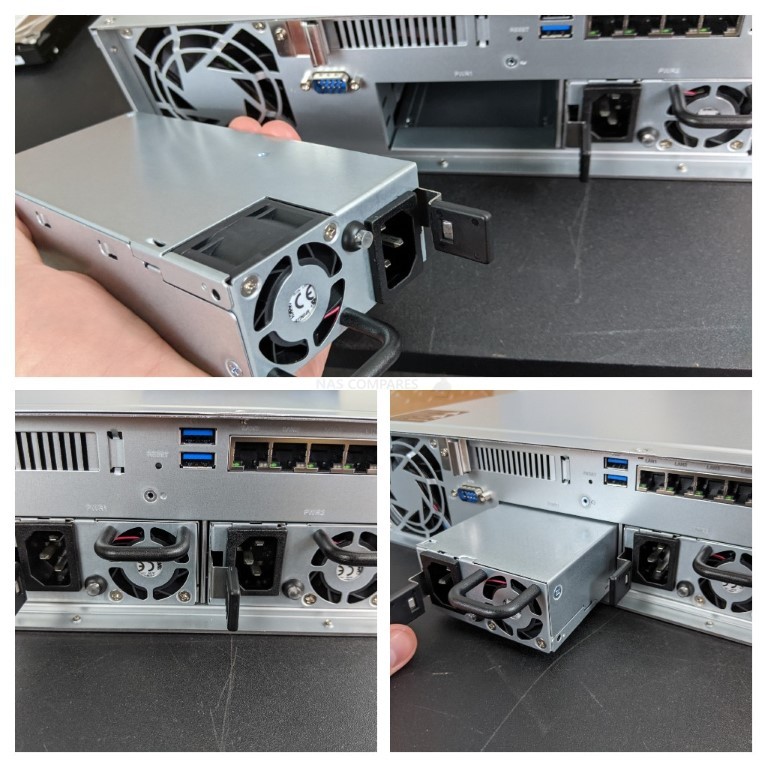
In terms of network connectivity, the Synology RS1221+ arrives with four individual Ethernet ports at one-gigabit each. That means that you can utilise these ports for separate connections, failover architecture and link aggregation to combine the total network bandwidth up to a potential 4Gbe maximum. For those that want greater than this level of network connectivity, you will have to look at occupying that available PCIe expansion slot with something a little more hardcore down the line (10Gbe, 25Gbe, etc), but as it stands the system will a maximum for 400MB/s+ out of the box. Alongside this, the RS1221+ also features two USB 3.2 Gen 1 ports (5Gbps) for external storage and a small range of network peripherals. Finally, we find an eSATA expansion port that allows you to connect the official four-bay RX418 expansion chassis and allows a total 12 bays of storage across the whole system once attached.
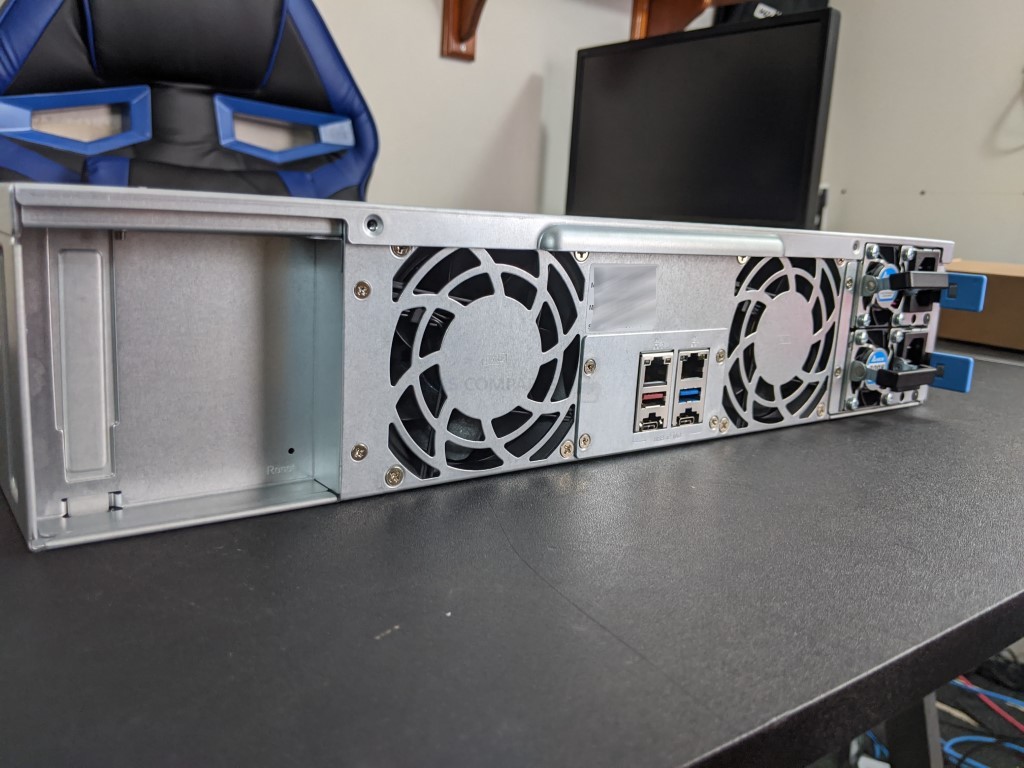
The QNAP TS-873AU on the other hand provides similar yet greater levels of connectivity compared with the RS1221+, but does it in a noticeably different way. For example, the QNAP TS-873AU features just two network interface ports, but these are 2.5Gbe and translate to 2.5x the ones found in the Synology, resulting in a maximum 500MB/s+ external throughput. The TS-873AU also features several USB ports in USB 3.2 Gen 2 & 1 architecture, allowing you to connect a larger selection of both storage and network adaptors. These USB ports (as well as the PCIe slots) are also used for expansion devices and allow the QNAP TS-873AU to attach several supported expansion devices (4/8/12/16 Bay chassis) and to a larger total number of drive bays than the maximum available on the Synology RS1221+. Ultimately, in terms of network connectivity, the Synology provides a familiar and standard range of external ports and connections, whereas the QNAP provides a more modern and higher performing selection of connections that nonetheless may not be completely supported by your existing hardware environment. On balance, I think the QNAP TS-873AU provides more in this section than the Synology RS1221+
Result – You Should Buy the QNAP TS-873AU NAS
Synology RS1221+ vs QNAP TS-873AU NAS – Performance
The performance of each of the NAS systems can be measured in a few separate ways and, once again, the Synology and QNAP ethos towards internal and external architecture is very, very present here in the RS1221+ and TS-873AU. In terms of traditional 1Gbe external performance, these two NAS systems are near enough identical, as both have both the general internal architecture to push through 100MB/s+ with ease. Though it should be highlighted that although both systems have the internal drive space of 8 Drives in a RAID to saturate their respective 1Gbe and 2.5Gbe connections with a supported switch via Link Aggregation, the QNAP provides a better single cable connection overall. With the use of sufficient drive media and the combining of all available network connections in link aggregation, the Synology RS1221+ will max out at 400MB/s+ with 4 ports, whereas the QNAP will provide 500MB/s+ with 2 ports.
Things are quite different in terms of 10Gbe support, however. Neither system arrives with a dedicated 10Gbe port and requires the installation of a 10Gbe network upgrade card. As these are 8-bay NAS systems, there is not quite the throughout to justifying a 2x 20 Port setup, but over 1x 10Gbe, the Synology RS1221+ NAS seemingly provides a solid 1000MB/s over both Read and Write, thanks to that PCIe Gen 3 x8 support. The QNAP TS-873AU arrives with a solid 10Gbe performance also that will like in the 1000MB/s in both read and write too, however, the winning factor once again, is that the QNAP also can reach 500MB/s read and write WITHOUT a 10Gb upgrade, thanks to those 2x 2.5Gbe ports. Of course you will need sufficient external network hardware in your home/office environment to take advantage of 10G, 2.5G or link aggregation at all, but ultimately it means that in a base level 1Gbe setup, things are pretty even and in a perfect setup, the QNAP TS-873AU will win overall in performance externally.
Result – You Should Buy the QNAP TS-873AU NAS
Synology RS1221+ vs QNAP TS-873AU NAS – STORAGE
This is probably the biggest and clearest distinction between these two devices and Synology and QNAP have clearly drawn a line in the sand with what they are prepared to offer at this £1k+ price tag. Both systems allow the installation of hard drive and solid-state drive media, as well as supporting expansion devices that allow you to add further storage to your system storage pool. But the media types supported range of performance and extend to which you can use that storage is wildly different comparing these two devices. The Synology RS1221+ provides 8 SATA hard drive bays that can also support 2.5 inch SATA SSD. This main storage area allows you to create any one of a range of traditional RAID configurations, as well as their own fluid proprietary configuration known as Synology Hybrid RAID (SHR). The core system utilizes btrfs as the de facto file system and although you can switch the system to ext4, a number of key Synology applications demand btrfs running. Btrfs presents a number of unique benefits to the system that includes file self-healing, faster-shared folder duplication and reduced impact made on the system resources when generating snapshots, allowing a greater number of snapshots of your storage to revert to, as well as less system slow down when they are created. As mentioned, you can attach expansion devices and the RS1221+ allows the connection of an eSATA expansion device that is JBOD and costs around £450 (RX418). There is a huge amount of storage potential here and the benefits of upgrading the performance with NVMe are desirable (using the Synology E10M20-T1 or M2D20 upgrade card), if optional. And let’s not forget about Synology hybrid RAID and the benefits that it brings to a more scaled approach to populating your NAS over the years. Still, the fact you can only add four more drives total to this 8 Bay NAS in its lifespan is a little disappointing.
Whereas the QNAP has a much larger number of expansion options available. It lacks the BTRFS of the Synology, sticking with the EXT4 file system, it also does not have the fluid SHR configuration, favouring traditional RAID levels. However, the larger array of expansion options cannot be ignored and definitely a plus for that long term business storage expandability. It is hard to choose an outright winner, as the advantageous factors of either device are very distinct with the Synology system favouring flexibility fro the start and some structural file advantages, whereas the QNAP keeps things in a relatively solid if unexciting way, but also factors in much, much more options for adding expansions and futureproofing your storage capabilities in years to come.
As bad as it might sounds, it has to be ANOTHER tie between them, as each of those clear storage-related advantages on each platform will appeal to different NAS buyers.
Result – IT’S A TIE! The Synology has better Day 1 Storage, but the QNAP has better long term storage options
Synology RS1221+ vs QNAP TS-873AU NAS – PRICE
Regardless of whether you are looking at the RS1221+ or TS-873AU for home or business use, the price tag and what you get for your money is always going to be an important factor. Although each system is quite similar, they do have noticeably different price points. The Synology RS1221+ is clearly the lower price of the two, something I RARELY say in a Synology comparison, arriving at a little over £1,000 in its single PSU form. In contrast, the QNAP is noticeably more expensive with its £1,300 price tag (also a single PSU version). This price difference may seem noticeably large between the two devices given the similar architecture and if price plays an important part in your purchasing decision, it has to be noted that the Synology is definitely the lower priced item here.
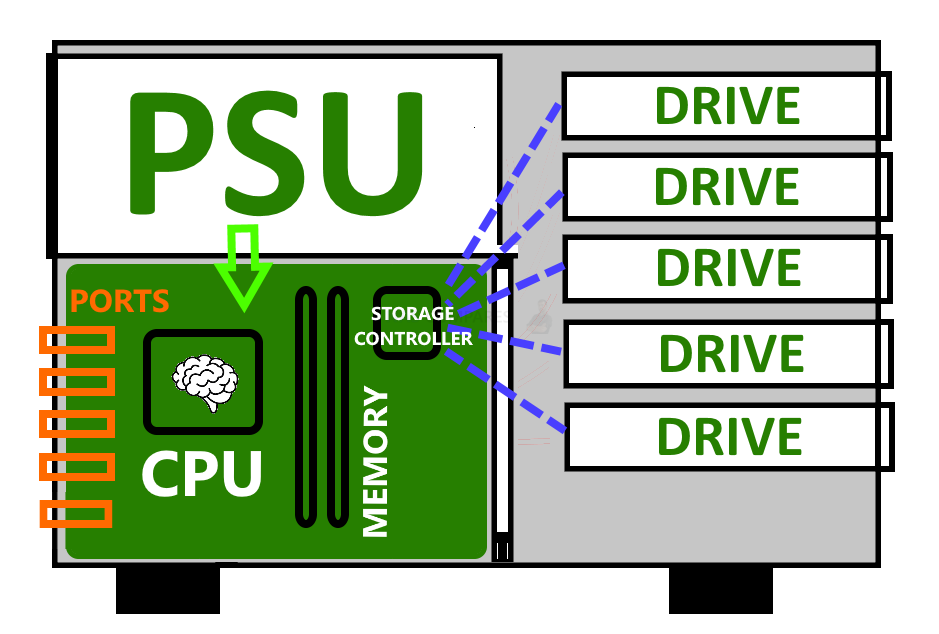
However, the price tag alone should not dictate value, though at the base level and with no upgrades or upscaled network architecture in consideration, the Synology still works out at the best value. However the upgradability and future-proofing of the QNAP cannot be overestimated and with larger support of expansion storage devices available, a much larger total memory maximum, 2.5Gbe network connectivity and faster USB ports as standard, the QNAP TS-873AU still provides a great deal more ways to scale up your network-attached storage in the lifespan of the system. That means that it has a higher glass ceiling technically than the Synology RS1221+, but the Synology RS1221+ (if you have no plans to upgrade your hardware environment in the next 3 to 5 years) still provides the best price and best day-one value.
Result – IT’S A TIE! The QNAP for Long Term Value, Synology for Software vs Hardware Balanced Value & Price
Synology RS1221+ vs QNAP TS-873AU NAS – CONCLUSION
If this comparison has shown you one core thing, it is that despite these devices appearing very similar in hardware, they both provide a different level of hardware support in their lifespan. The Synology provides you with a solid, safe and reliable solution that finds the best balancing act between hardware and software in its price tag. It may not seem like a huge technical upgrade over the last two generations of this series, but this device is marketed on reliability, durability and consistency. The QNAP TS-873AU is a device that, although it provides a huge amount of software on both day 1 and day 1000, arrives with a greater focus on hardware and more ways to upgrade the solution as your business grows too. Both solutions are not the most powerful hardware that either brand has presented to the market in the last 12-months, but each one is very much a product of the respective company priorities and whichever one you buy, you will get a fantastically capable solution. It is just a question of how much you need the system to grow in line with your business down the line.
| SYNOLOGY RS1221+ NAS Drive
|
QNAP TS-873AU NAS Drive
|
Best NAS for General Storage = QNAP TS-873AU NAS
Best NAS for Software = Synology RS1221+ NAS
Best NAS for Hardware = QNAP TS-873AU NAS
Best NAS for Surveillance = Synology RS1221+ NAS
Best NAS for Virtual Machines = QNAP TS-873AU NAS
Best NAS for Photographers = Synology RS1221+ NAS
Best NAS for Video Editors = QNAP TS-873AU NAS
Best NAS for Business = QNAP TS-873AU NAS
Best NAS for Plex Media Server = Synology RS1221+ NAS
📧 SUBSCRIBE TO OUR NEWSLETTER 🔔 This description contains links to Amazon. These links will take you to some of the products mentioned in today's content. As an Amazon Associate, I earn from qualifying purchases. Visit the NASCompares Deal Finder to find the best place to buy this device in your region, based on Service, Support and Reputation - Just Search for your NAS Drive in the Box Below
🔒 Join Inner Circle
Get an alert every time something gets added to this specific article!
Need Advice on Data Storage from an Expert?
Finally, for free advice about your setup, just leave a message in the comments below here at NASCompares.com and we will get back to you.
 Need Help?
Where possible (and where appropriate) please provide as much information about your requirements, as then I can arrange the best answer and solution to your needs. Do not worry about your e-mail address being required, it will NOT be used in a mailing list and will NOT be used in any way other than to respond to your enquiry.
Need Help?
Where possible (and where appropriate) please provide as much information about your requirements, as then I can arrange the best answer and solution to your needs. Do not worry about your e-mail address being required, it will NOT be used in a mailing list and will NOT be used in any way other than to respond to your enquiry.
TRY CHAT
Terms and Conditions
This description contains links to Amazon. These links will take you to some of the products mentioned in today’s video. As an Amazon Associate, I earn from qualifying purchases


Beelink ME Pro NAS Revealed
Best SOLID STORAGE NAS of 2025
Should You Worry About the NanoKVM Hidden Microphone?
Best Cheap NAS of 2025
Minisforum MS-02 Ultra - WHO IS THIS FOR??? (The First 48HRs)
Why People Use TrueNAS, UnRAID and Proxmox to Turnkey NAS (Synology, QNAP, etc)
Access content via Patreon or KO-FI
Discover more from NAS Compares
Subscribe to get the latest posts sent to your email.


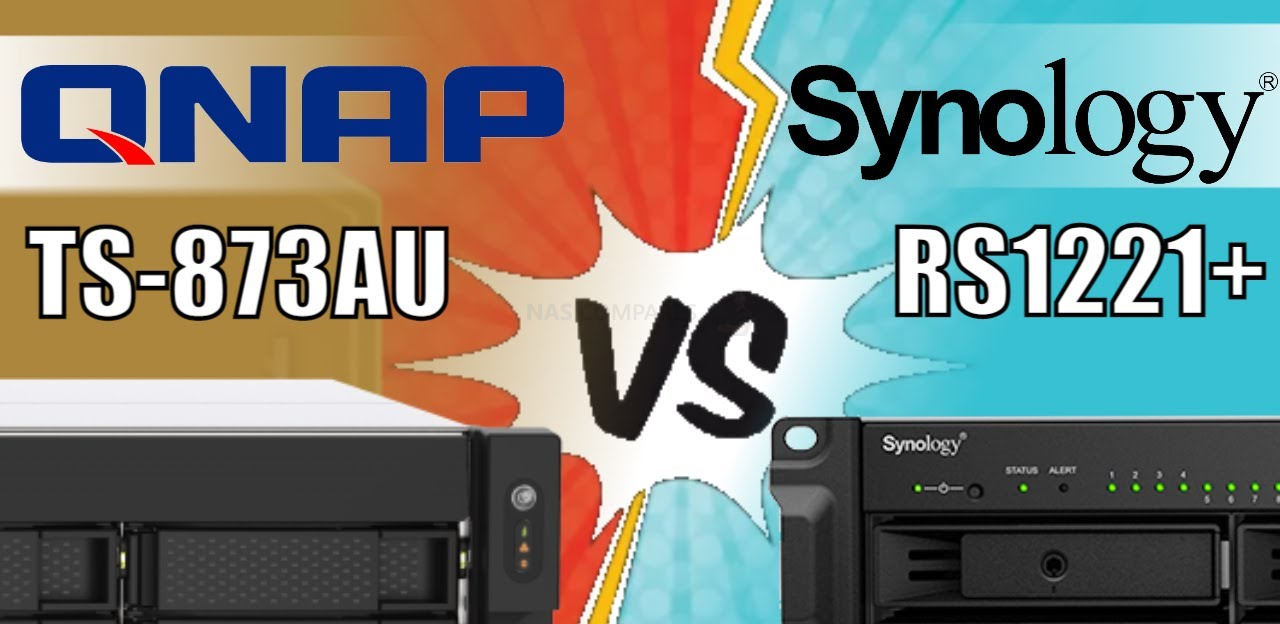






Quick question. Can you expand RAID configurations across extensions with both TL and TR units? I suppose this is highly discouraged because if one NAS unit fails, the whole raid goes to shit but I’m just curious if it can be done and how would it perform. Are there any videos on your channel on this topic?
I suppose that if you connect both units to the same UPS, it should not be a problem, right?
REPLY ON YOUTUBE
This video could have been better if it didn’t focus so much on your personal preferences. Even though you mentioned several times that it would be up to the user to decide, you constantly propped up Synology and made excuses for it while over-criticizing QNAP’s extensive options. Let the specs and design speak for themselves without so much opinion and bias. This approach would be more effective if the goal is to let the user decide what works best for them.
REPLY ON YOUTUBE
Old video, but I’ve got a question (noob here). Can the TL-D800C be used as a simple hard drive enclosure as-is? As-in, slot in 8 drives in it then plug the USB cable onto a Windows 10 PC and the PC would detect those drives like external/internal hard drives?
Asking because I’ve been looking for a mass storage solution but would just like it to be simple via USB and where I can just add drives when it gets full. I don’t really want to go through all the trouble of setting up RAID setups or network arrays as it’s mostly for personal use anyway, but I have a lot of stuff (mainly backups of my games and media), and I would like to reduce my external HDD clutter.
REPLY ON YOUTUBE
I’m rewatching this one again, and I’m still torn over the Qnap vs the Synology.
REPLY ON YOUTUBE
This video tutorial is from 2020, and since then, DSM 7 has been released. Even more polished and refined User Interface on Synology NAS, which makes Synology a big winner, in my opinion.
For all Apple fans, Synology seems like a company that could have been acquired by Apple. Same care on the user experience, to make it simple with more advanced options under the hood, but quite hidden, a slow pace for updating the system.
On the negative side, Synology gets greedier and greedier on hardware and wants to retain more control, hence their difficulties in maintaining a hard drive compatibility list and selling their own hardware.
REPLY ON YOUTUBE
Can you get the JBOD expansion unit and format it with RAID0 in macOS? Or is it locked to JBOD?
REPLY ON YOUTUBE
This looks great, however its now 2022 and I’m looking to get a Synology DS1821+ With I understand DSM 9.x. Any chance of a newer series (or are the differences still not that great to 7.0)?
REPLY ON YOUTUBE
I’ve only ever used Synology, but truth be known , the GUI always irked me.
Based on what i’ve seen, the upfront approach of Qnap suits my brain much better.
Given the way Qnap hardware stands, i will consider adding Qnap devices going forward
REPLY ON YOUTUBE
Synology wipes the floor with qnap
REPLY ON YOUTUBE
Nice, looking for a half depth rack mount. Thanks
REPLY ON YOUTUBE
Synology should have a God Mode like Windows too. ;>>>
REPLY ON YOUTUBE
I’m a long time viewer of your videos. Running a small business, your tips and instructions have helped me for years! Thank you for all your efforts.
REPLY ON YOUTUBE